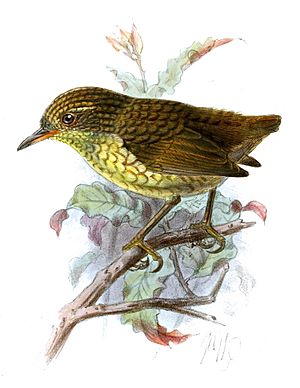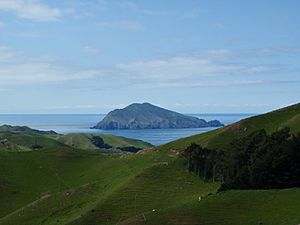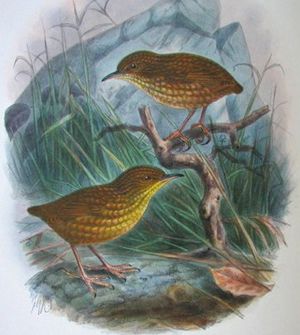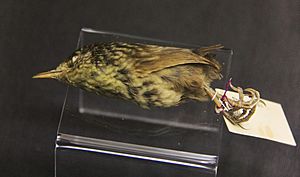Lyall's wren facts for kids
Quick facts for kids Lyall's wren |
|
|---|---|
 |
|
| 1895 illustration by John Keulemans | |
| Conservation status | |
| Scientific classification | |
| Genus: |
Traversia (bird)
|
| Species: |
lyalli
|
The Lyall's wren or Stephens Island wren (Traversia lyalli) was a small bird that couldn't fly. It belonged to the New Zealand wren family. These birds were once found all over New Zealand. But by 1894, their last home was Stephens Island in Cook Strait.
Many people think a single cat owned by a lighthouse keeper, named Tibbles, caused the wren's extinction. However, the wren actually disappeared because of many wild cats living on the island. The wren was officially described by scientists in 1894 and became extinct very soon after.
Contents
About Lyall's Wren
The scientific name for this bird, Traversia lyalli, honors David Lyall. He was an assistant lighthouse keeper who first showed the bird to scientists. The bird was placed in its own special group, Traversia. This name honors Henry H. Travers, a naturalist who collected many specimens from Lyall.
Traversia is part of the Acanthisittidae family, known as the New Zealand wrens. These birds aren't true wrens. They are a similar-looking group of songbirds that first appeared a very long time ago. DNA tests show that Lyall's wren is the oldest and most unique bird in this family.
What it Looked Like
Lyall's wren had feathers that were olive-brown. It also had a yellow stripe above its eye. The underside of female birds was grey. Males had a brownish-yellow underside. The edges of its body feathers were brown.
Why it Couldn't Fly
The most special thing about Lyall's wren was that it couldn't fly. Its breastbone was small, and its wings were short and round. It is the most famous of four known flightless songbirds. All these birds lived on islands and are now extinct. The other three were two other New Zealand wrens and a bunting from the Canary Islands. These were only found as fossils recently. They died out in ancient times.
People only saw living Lyall's wrens twice. The lighthouse keeper called it a 'rock wren'. He said it was mostly active at night. It would "run around the rocks like a mouse" and was too fast to catch.
Where it Lived
In recent history, Lyall's wren was only found on Stephens Island. But long ago, it lived all over New Zealand. This was before the Māori settled the land. Scientists have found its bones in caves. These bones were left behind by laughing owls on both main islands.
The wren likely disappeared from the mainland because of Polynesian rats. These rats, also called kiore, were brought by the Māori people. It might seem strange for a flightless bird to live on an island 3.2 km from the mainland. Also, Hamilton's frog, which can be harmed by salt water, lives there. But Stephens Island was connected to the rest of New Zealand during the last ice age. At that time, sea levels were much lower.
How it Became Extinct
Many common beliefs about how this bird died out are not quite right. For example, some stories say a single cat killed all the birds. But research has shown the real story of the bird's last days.
The Story of its Disappearance
- 1891-1892: People started building a lighthouse on Stephens Island. They cleared land for the lighthouse and a small farm. Workers reported seeing "two kinds of wren."
- 1894: The lighthouse began working in January. Around February, a pregnant cat escaped onto the island. By June, a cat started bringing dead small birds to the lighthouse keepers' homes. David Lyall, who liked nature, sent one of these birds to a scientist named Walter Buller.
- Mid-1894: Buller quickly realized it was a new species. He prepared to describe it for a science journal. Lyall found more specimens. Another person, Henry Travers, bought nine birds from Lyall. Travers then sold these birds to Walter Rothschild, a very rich collector. Travers knew the birds were rare and told Rothschild they would soon be gone.
- Late 1894: Rothschild quickly described the bird as Traversia lyalli. This happened before Buller's description was published. This caused a big disagreement between the two scientists.
- 1895: In February, Lyall wrote to Buller that "the cats have become wild and are making sad havoc among all the birds." In March, a newspaper reported that the bird was likely extinct. Travers and his helpers searched the island but found no more wrens.
- Late 1895: Travers told a scientist that Lyall couldn't find more specimens. He believed the bird was extinct. He tried to sell two preserved birds for a very high price.
- 1896: Lyall left Stephens Island. Another scientist visited the island but found no wrens.
- 1897-1899: The lighthouse keepers asked for shotguns to kill the "large number of cats running wild on the island." One keeper shot over 100 wild cats in less than a year.
- 1901-1905: More specimens were sold to museums.
- 1925: The last wild cats on the island were finally removed.
What We Learned
It seems the Lyall's wren was wiped out by wild cats during the winter of 1895. By then, the second generation of cats born on the island would have been old enough to hunt. These young cats would have found the wrens easy prey. Some people thought habitat destruction also played a role. However, in 1898, the island was still mostly covered in forest. Most of the habitat destruction happened after 1903, by which time the Lyall's wren was already extinct.
Where to See Specimens
About 16 to 18 preserved specimens of Lyall's wren exist today. These were collected by the lighthouse keepers' cats, the keepers themselves, and professional collectors.
You can find specimens in several museums around the world:
- The Natural History Museum in London has three specimens.
- The American Museum of Natural History in New York City has four specimens.
- The Academy of Natural Sciences in Philadelphia has one.
- The Harvard Museum of Comparative Zoology in Cambridge, Massachusetts has one.
- The Carnegie Museum of Natural History in Pittsburgh has one.
- The Canterbury Museum in Christchurch, New Zealand, has two.
- The World Museum Liverpool in England has one.
- The Museum of New Zealand Te Papa Tongarewa in Wellington, New Zealand, has one.
- The Otago Museum in Dunedin, New Zealand, has one.
Lyall's Wren in Media
Lyall's wren was shown in the episode "Strange Islands" of the TV show South Pacific. This episode first aired on June 13, 2009.
It was also featured in the YouTube show "Citation Needed" by Tom Scott. That episode was released on June 8, 2017.
See also
 In Spanish: Xenicus de Lyall para niños
In Spanish: Xenicus de Lyall para niños






